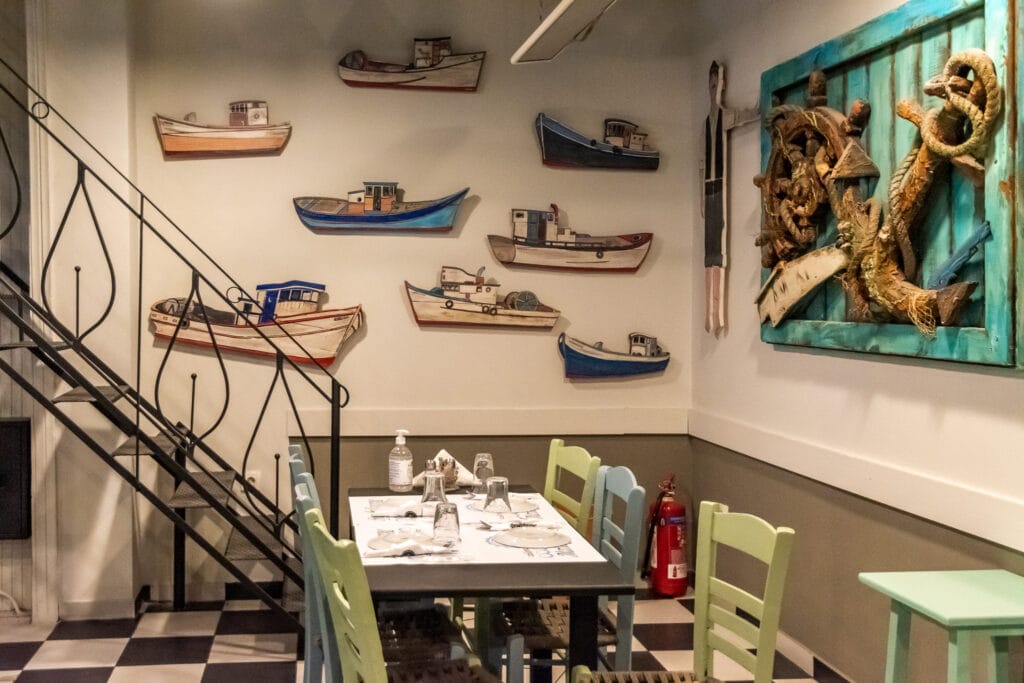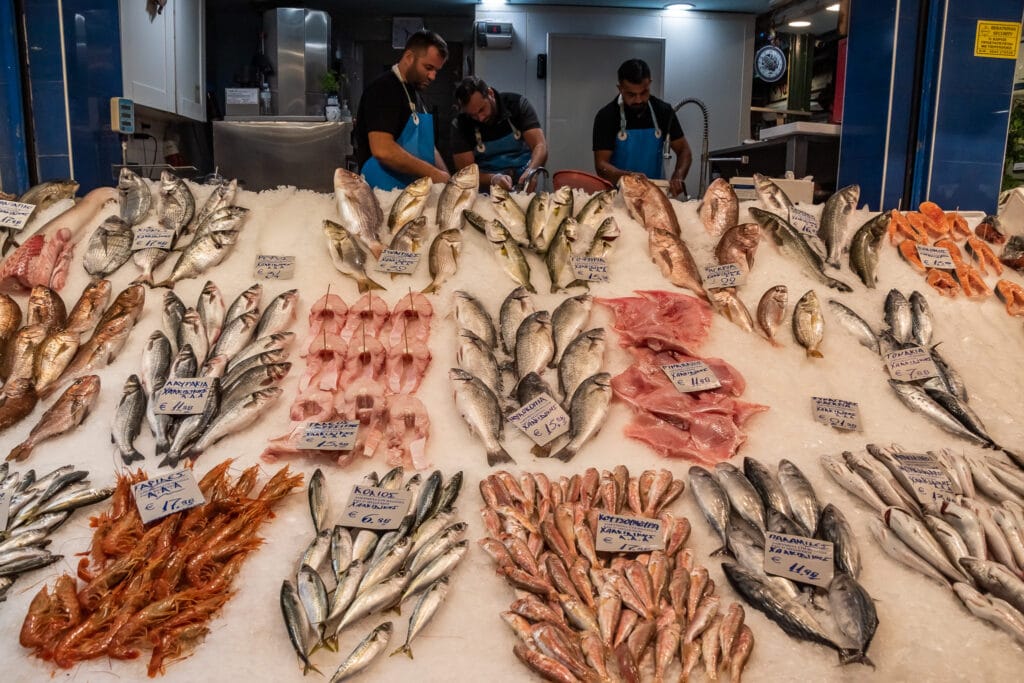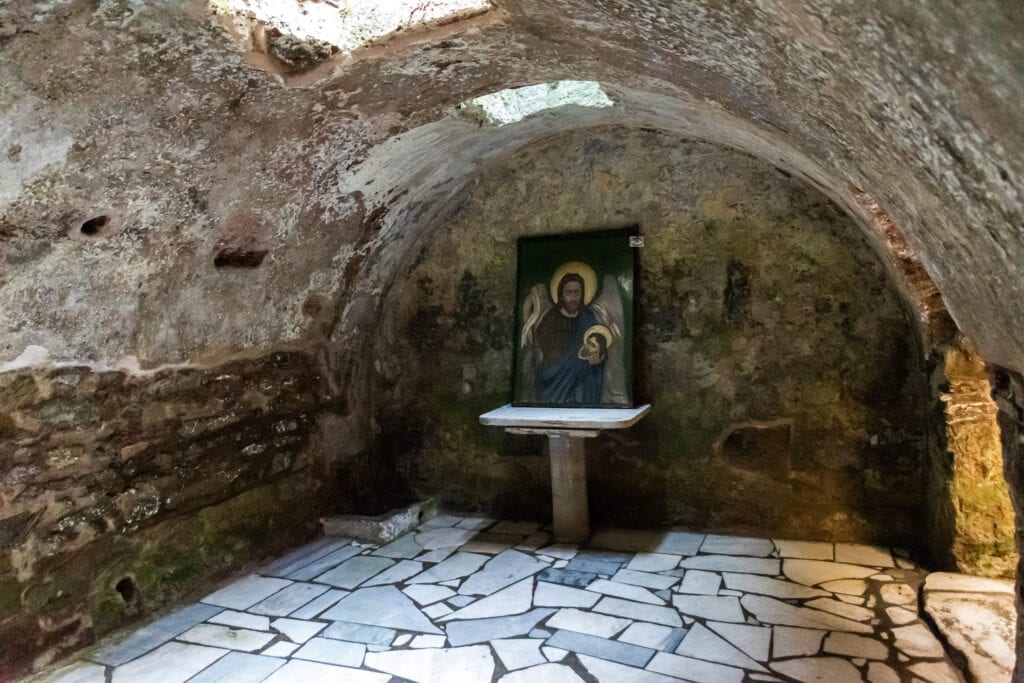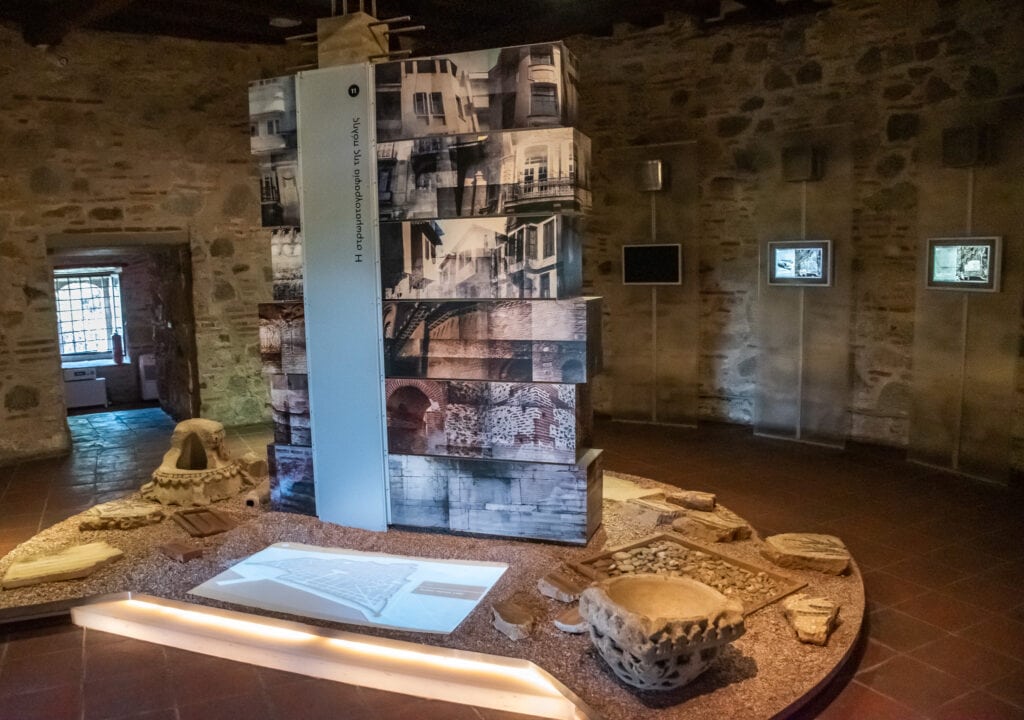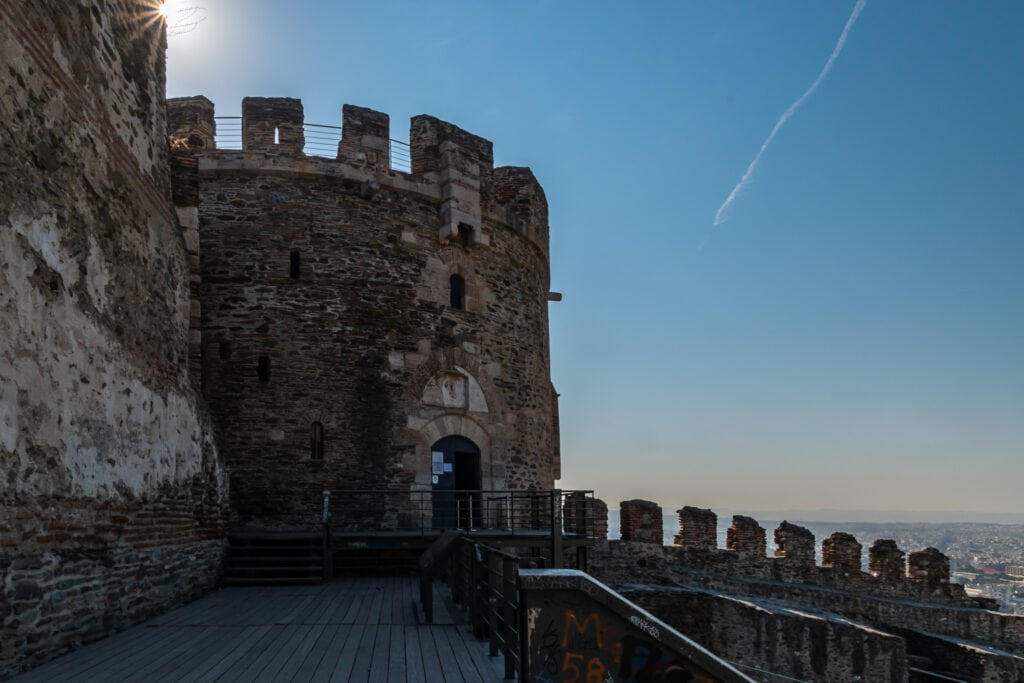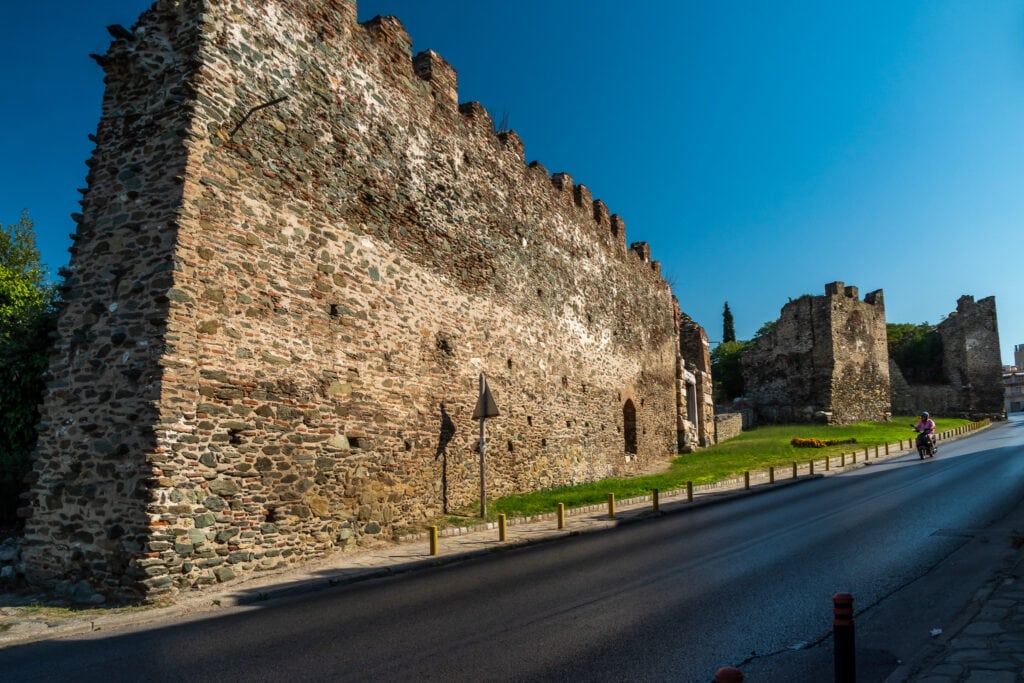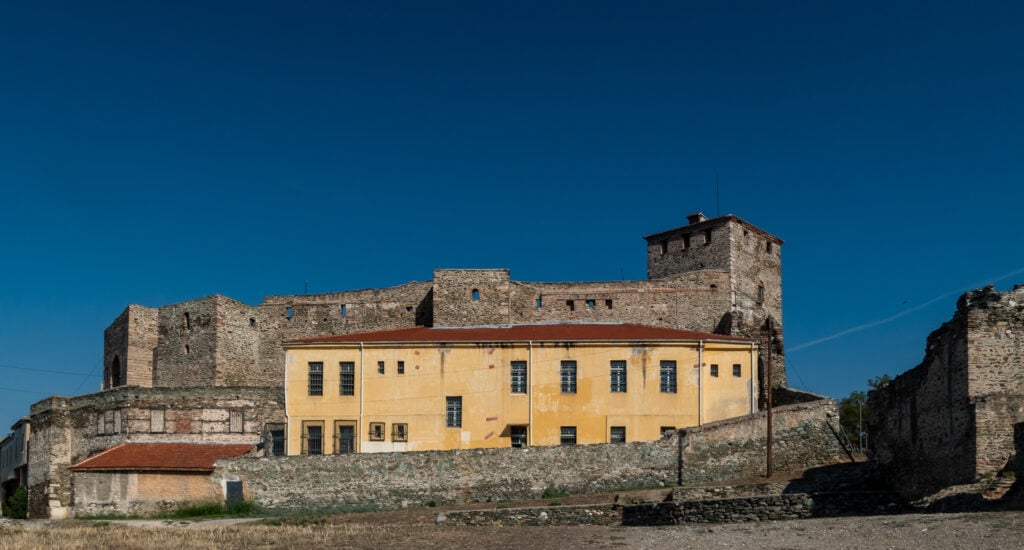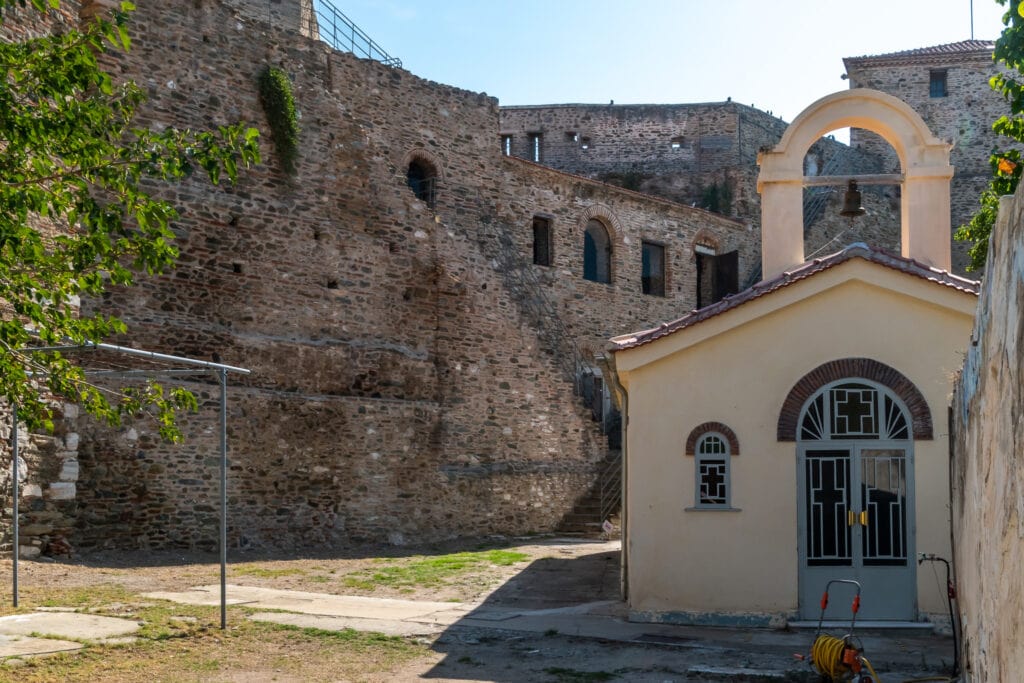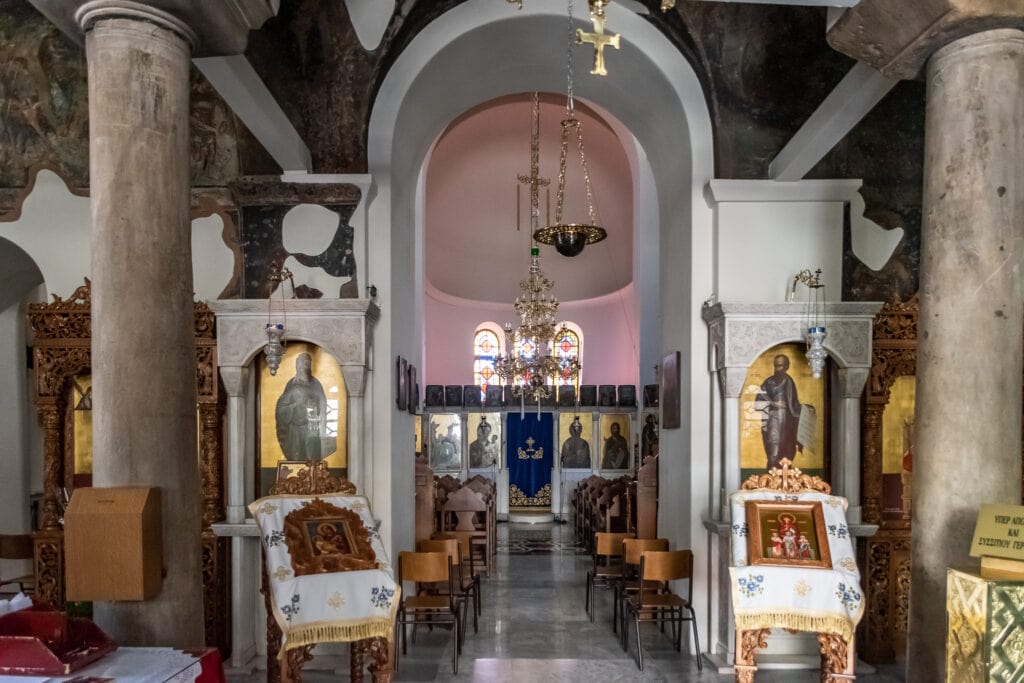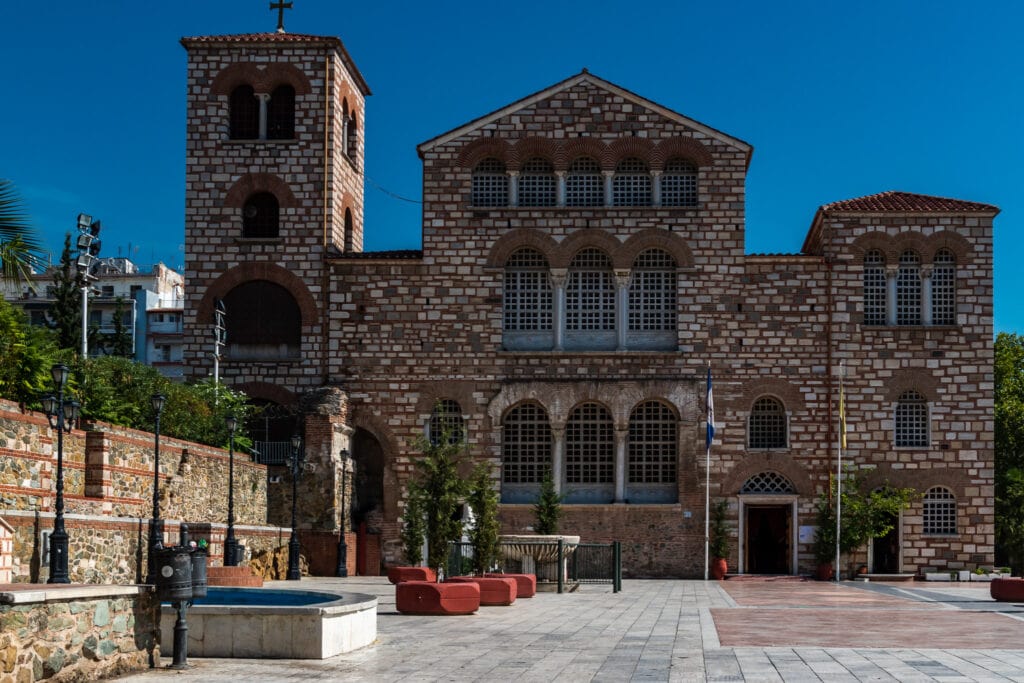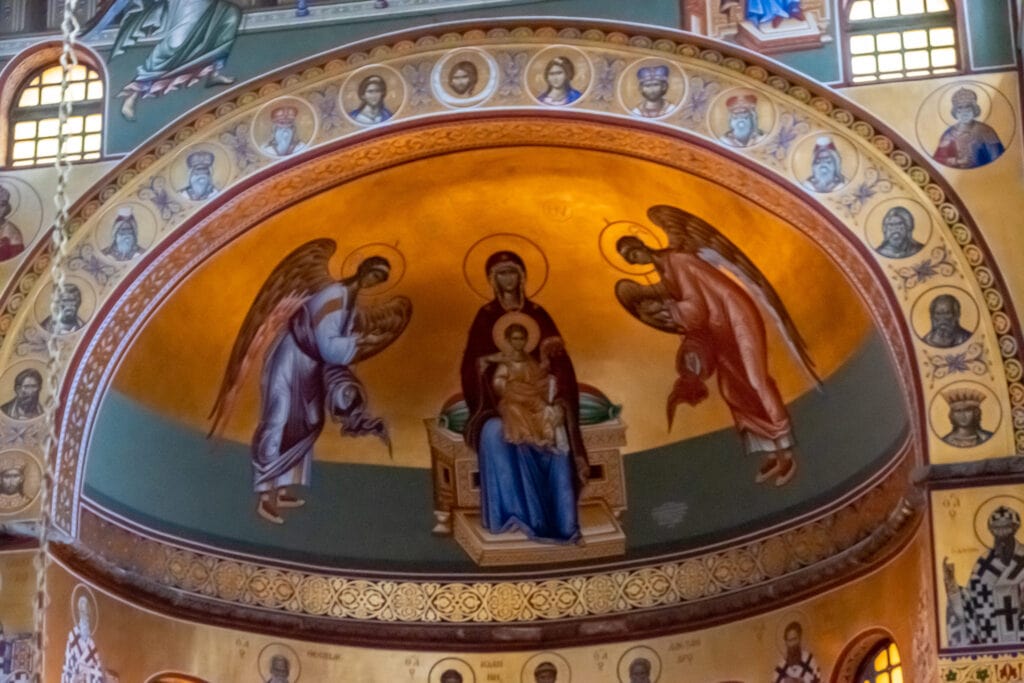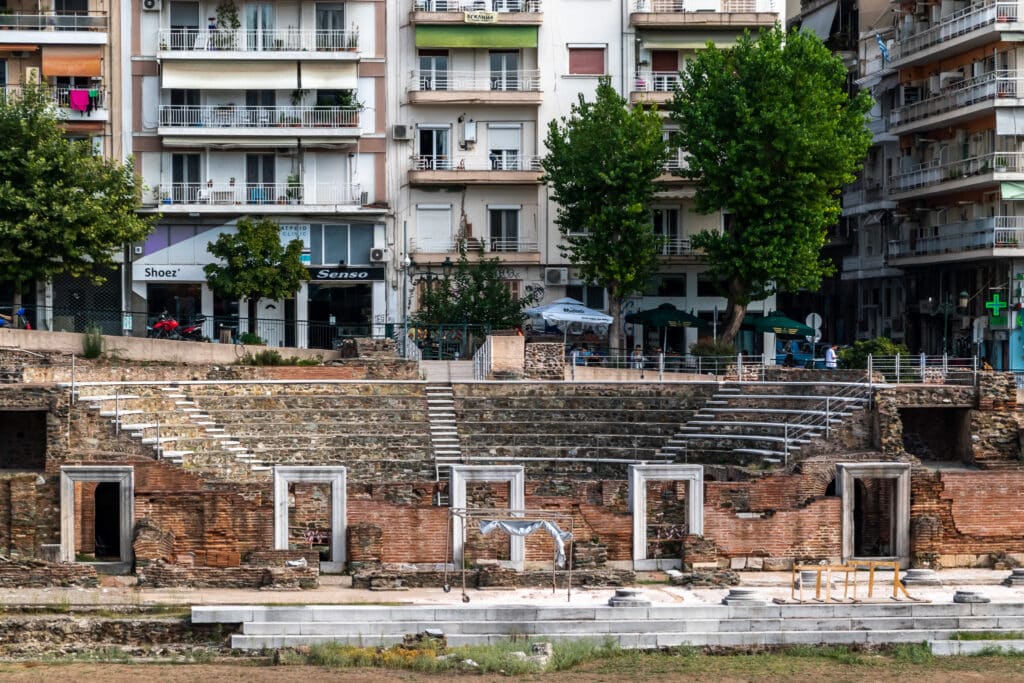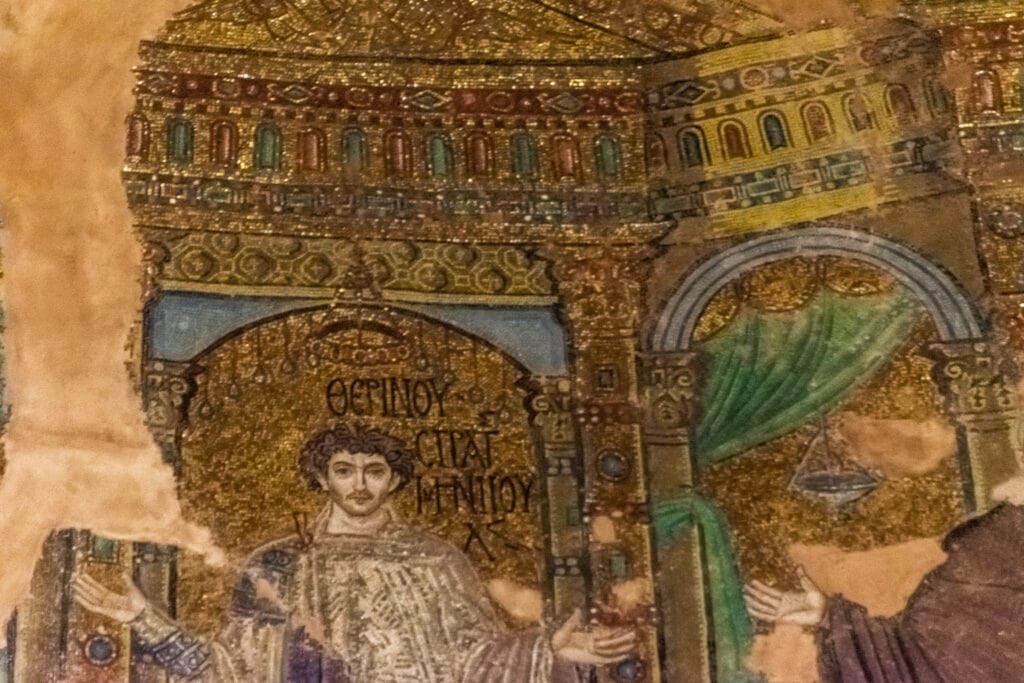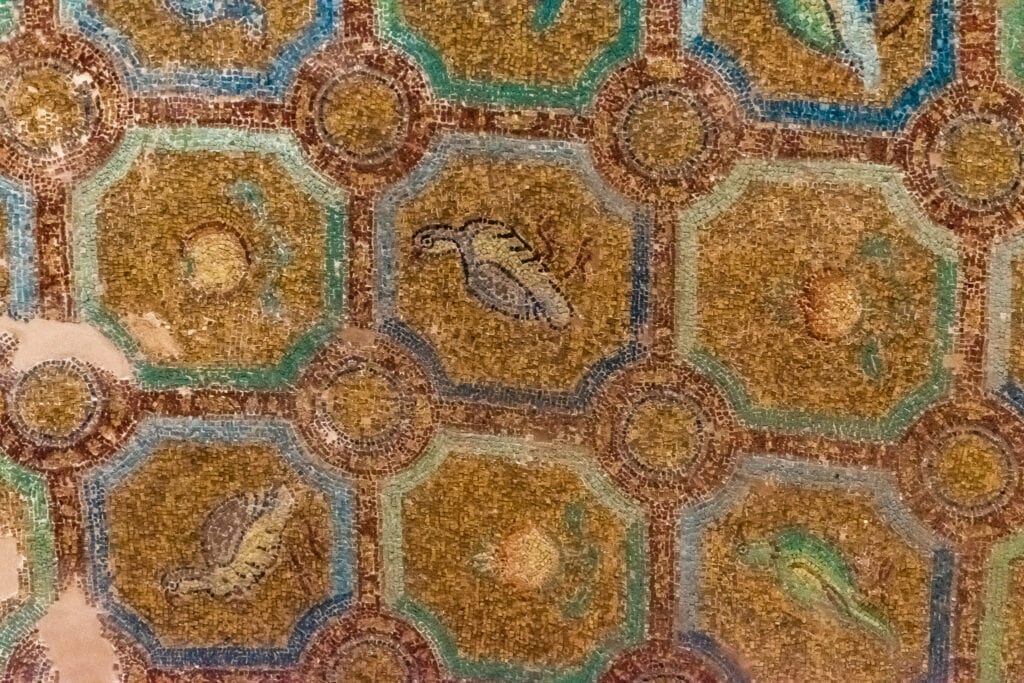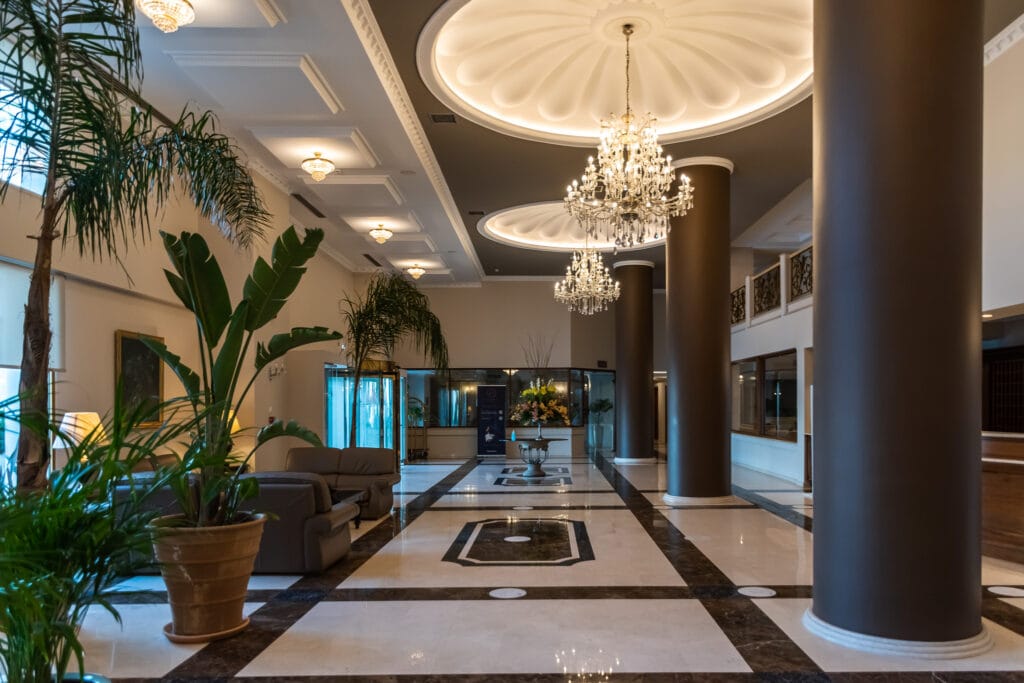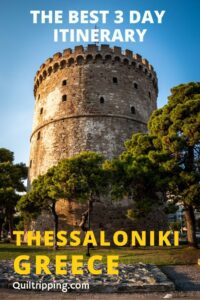Last Updated on 12/22/22 by Rose Palmer
Three days in Thessaloniki was all the time I had to discover all the diverse offerings in Greece’s second largest city. I would have liked more time, but that was what my schedule allowed, so I made the most of my time in this cosmopolitan metropolis and managed to see all the highlights.
Many travelers feel that a visit to Athens and a few Greek islands means that their trip to Greece is complete. However, skipping the delights of Greece’s Macedonia region, and its economic center of Thessaloniki, would be a shame.
Like the rest of Greece, Thessaloniki has a long and rich history. The city was founded in 315 BCE by Cassander who named it after his wife Thessalonike – the daughter of Phillip II and the sister of Alexandeer the Great.
The city was important to the Romans once they became established in this area, and even after that empire waned, it was still the second largest city after Constantinople during the subsequent Byzantine period.
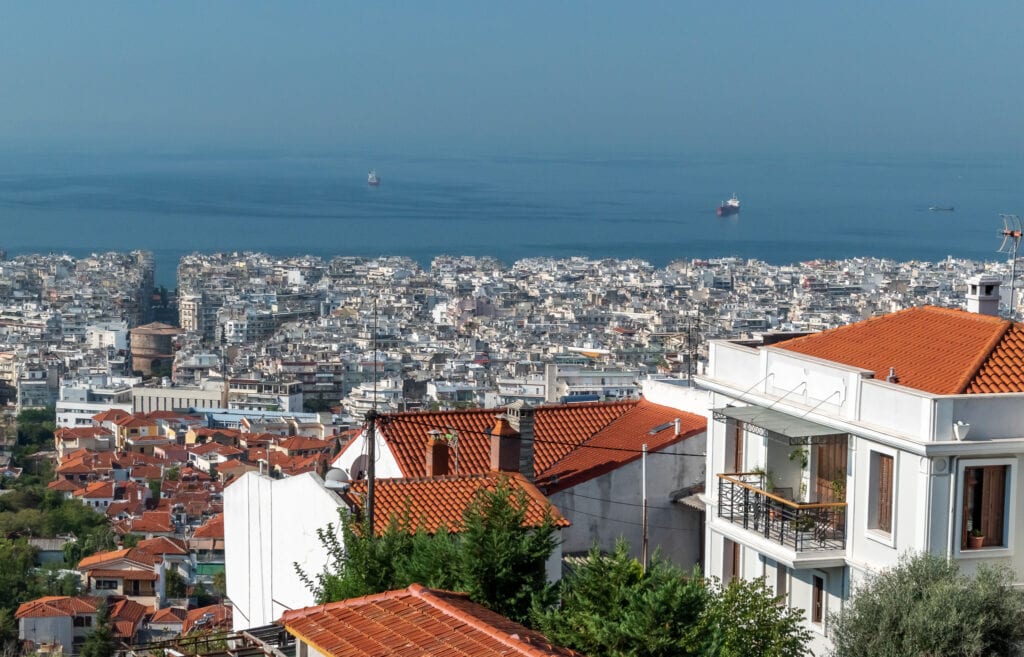
After the Ottomans conquered the city in 1430, Thessaloniki still remained a busy seaport. It ultimately became a part of Greece in 1912 when the Ottomans were ousted from the region.
Thessaloniki is also Greece’s cultural capital and offers many theaters, cinemas and concert venues. It also has 5 universities, and all those students definitely gave this city a youthful vibe.
How to get to Thessaloniki
You can get to Thessaloniki easily by plane, train, or automobile. The Thessaloniki International Airport is a short 20 minute drive from the city center. There are many direct flights to Thessaloniki from cities all across Europe with a variety of airlines. Of course, you can also fly direct from Athens in just under an hour.
If you like train travel, Greek railways can take you from Athens to Thessaloniki in about 4 hours.
I drove from Athens to the region on a very well maintained toll highway. It was about a 5.5 hour drive from Athens. I was able to easily pay the many tolls via a credit card. There were also plenty of very modern and clean rest stops along the way.
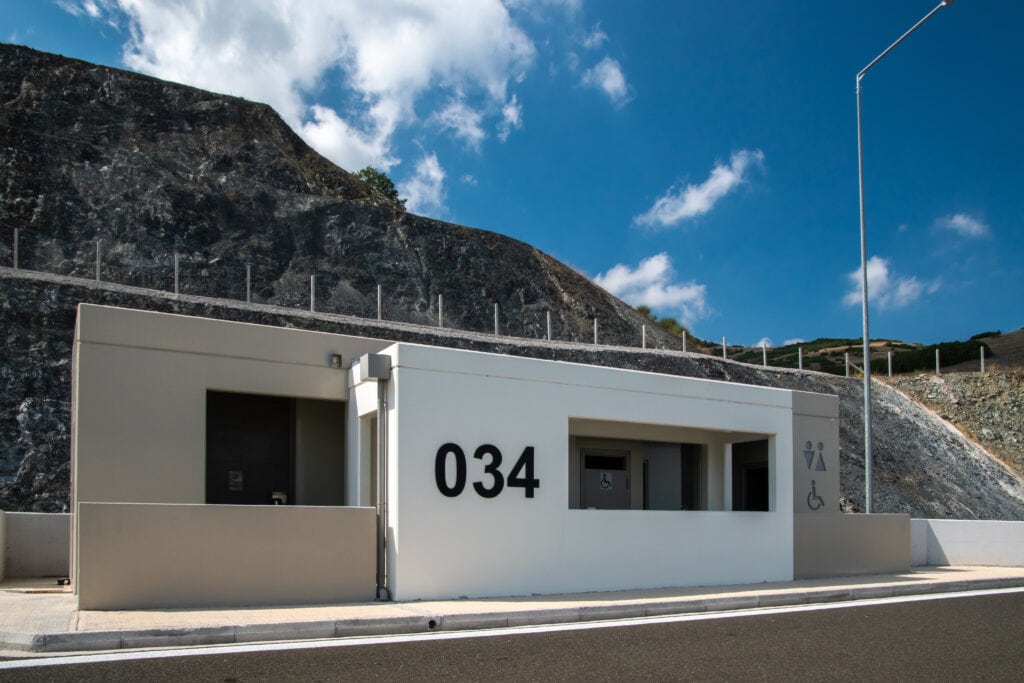
There are also busses from Athens to Thessaloniki and a ferry from Athens that takes about 27 hours.
To find which transportation options are best for you, I suggest using the Rome2Rio website or app.
My itinerary for 3 days in Thessaloniki
After a devastating fire destroyed two thirds of the city in 1917, the reconstruction plan included wider streets, more public squares and improved traffic flow, all while keeping the city’s old and historic elements intact. It was this historic core of the city that I planned to explore.
Day 1 – Discovering the many faces of Thessaloniki
I decided to spend my first full day discovering the many sights along Thessaloniki’s extensive waterfront and the neighborhoods nearby, experiencing some of the non-touristy, “real” city life. The harbor and its port have played a key role to the city’s economy and history since Roman times, and today, it is also a pleasant place to stroll, eat, drink and take in a beautiful sunset.
I started my walk at MOMus – The Experimental Center for the Arts. This little museum would be a nice stop for anyone interested in contemporary Greek art, with exhibits ranging from photography to textiles to multimedia works.
Just down the street from MOMus at Eletherias or Freedom Square was the very moving holocaust memorial. After the Nazis occupied Greece during WWII, they deported almost all of the Jewish population in Thessaloniki, and essentially decimated the largest Jewish population in Greece. Eletherias Square was where the many Jewish residents were rounded up before they were put on trains and transported to the concentration camps.

The Holocaut memorial sculpture by Nandor Gris is called “Menorah in Flames”. This moving piece has seven “candle” branches made up of emaciated human bodies surrounded by fire. The plaque on the sculpture reads:
“DEDICATED BY THE GREEK PEOPLE TO THE MEMORY OF THE 50,000 JEWISH GREEKS OF THESSALONIKI DEPORTED FROM THEIR MOTHER CITY BY THE NAZI OCCUPATION FORCES IN THE SPRING OF 1943, AND TERMINATED IN THE GAS CHAMBERS OF AUSCHWITZ – BIRKENAU DEATH CAMPS”.
Two blocks north east of the sculpture is the Jewish Museum of Thessaloniki. Here you can learn all about the history and legacy of one of the oldest Jewish communities in Europe (Paul the Apostle came to teach here during his extensive travels).
I actually continued my walk along the waterfront to Arestitoleous Square, which acts as both the social and political heart of Thessaloniki. The beautiful square is surrounded by neoclassical style buildings and has been the stage for speeches by prime ministers, rallies for all sorts of causes, and the annual Christmas tree lighting.
The square is lined with cafes, restaurants, and bars and is a great place to take a break and watch the locals as they go about their daily routines. If you are looking for centrally located accommodations, the Electra Palace Hotel sits on the square, is well rated, and has a rooftop terrace restaurant and bar with great views over the sea.
From this square, Aristotelous Avenue leads uphill past some of Thessaloniki’s 2300 years of ancient Greek sites, which I explored on my second day in the city. For now I just continued a few more blocks in search of some of the local markets and shops.
On Komninon street I discovered a 15th century Ottoman hammam (Turkish bath) with an outdoor cafe and flower market next door along with a few very photogenic shops nearby.
The markets in Thessaloniki
The nearby Modiano Market was a covered market hall where I found a variety of food vendors and eateries in a very eclectic and artsy setting. Since it was morning, nothing was open yet, but I imagine later in the day this spot is hopping.
A couple of blocks further along on Aristotelous Avenue, the Kapani Market offered a large variety of meats, fish, cheeses, spices, traditional Greek specialties, and a host of other staples needed to put a great meal on the table. Even though it was midweek, locals were busy shopping and there were very few tourists around.
It was a joy to explore this market and discover the many unique ingredients that are part of every day Greek cooking.
On the other side of Aristotelous Avenue the Athonos Square Market had small shops selling handmade wooden furniture and wicker products made by local craftsmen in the traditional way.

Cathedral Church of Hagia Sofia
I continued my walk along Ermou Street to Hagia Sofia square, the home of the beautiful Church of Saint Sofia. Like its other namesake, this church is very similar to the Hagia Sofia church in Istanbul after which it was modeled, though built on a smaller scale.

This Hagia Sofia was built as a church in the 7th century and then became the city’s cathedral during the crusades in the 13th century. When the Ottomans took over in the 15th century, the Hagia Sofia was converted into a mosque, again, like its namesake in Constantinople. After the Greek army ousted the Ottomans in 1912, the Hagia Sofia was once again turned into a church.
Inside, the church was decorated with a variety of paintings, mosaics, carved wood sculptural details and Orthodox Christian icons. The beauty and intricacy of the artwork took my breath away. It was so completely different from other, western European Christian churches I had visited to date.

Like the Hagia Sofia in Istanbul, this one in Thessaloniki was also decorated with mosaics and colorful paintings. Here however, the Orthodox iconoclastic influences were much more pronounced.

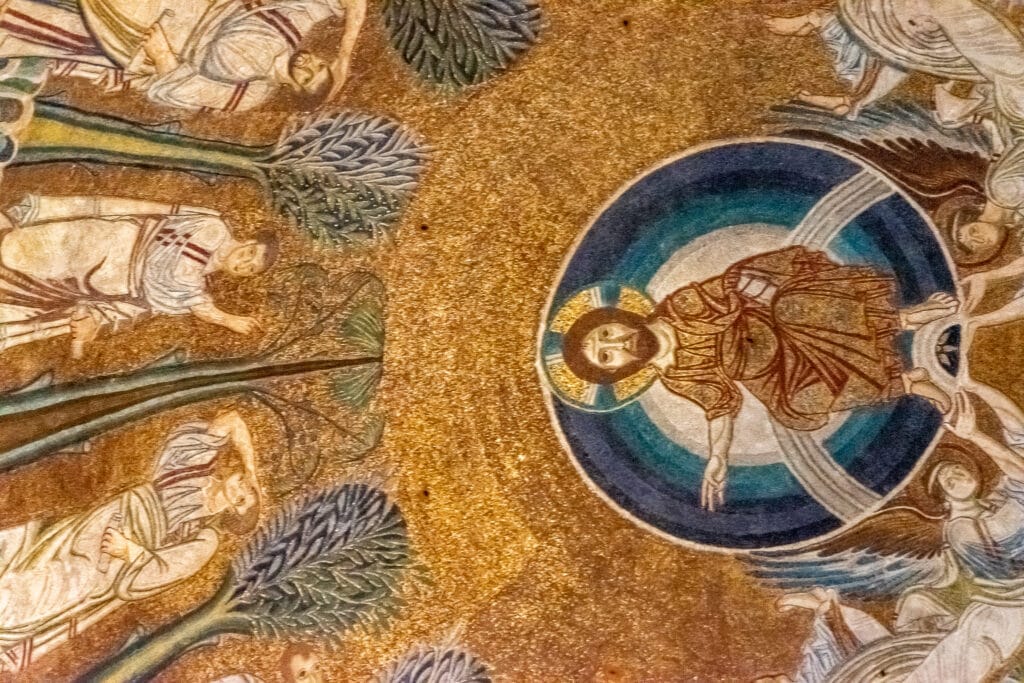
I found the iconostasis (the screen seperating the sanctuary from the nave) to be especially beautiful with its elaborate wooden carvings and many paintings. This is one aspect that distinguishes the Eastern Orthodox churches from the many churches I had seen in western Europe.
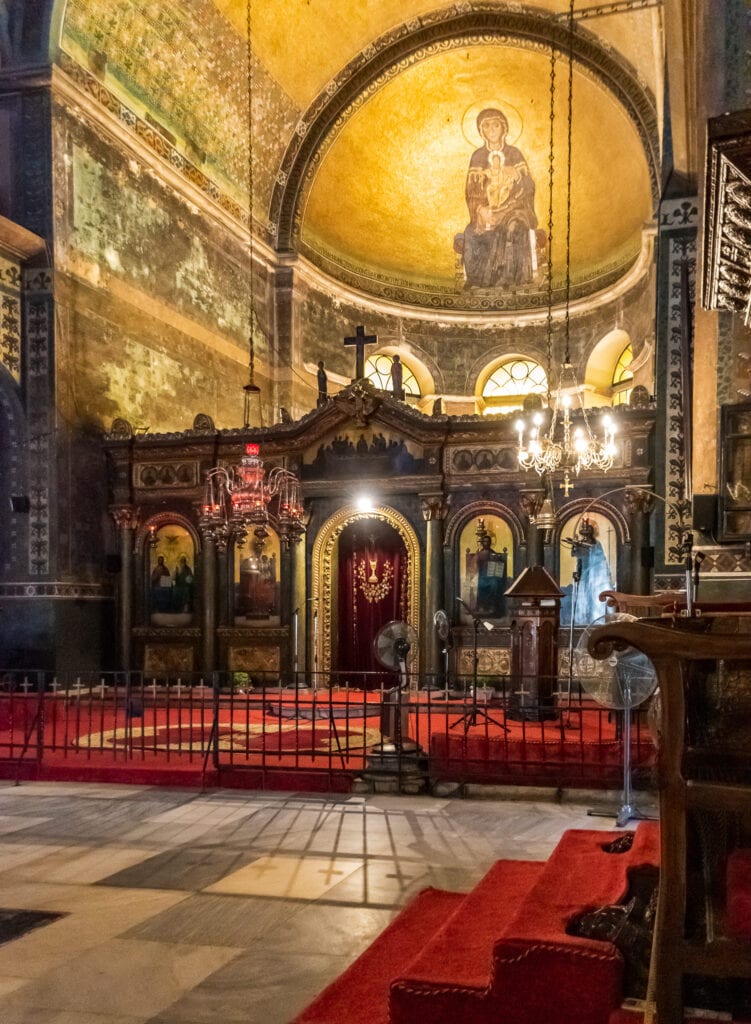
The Hagia Sofia church is one of 15 ancient Byzantine sights that are listed as UNESCO World Heritage sites in Thessaloniki. I was planning on seeing more of them on my second day in the city.
Catacombs of John the Baptist
Heading south from the church and across the street I discovered the Catacombs of St. John the Baptist. At street level I found a modern place of worship, but a set of stairs led underground to a series of ancient stone lined chambers.
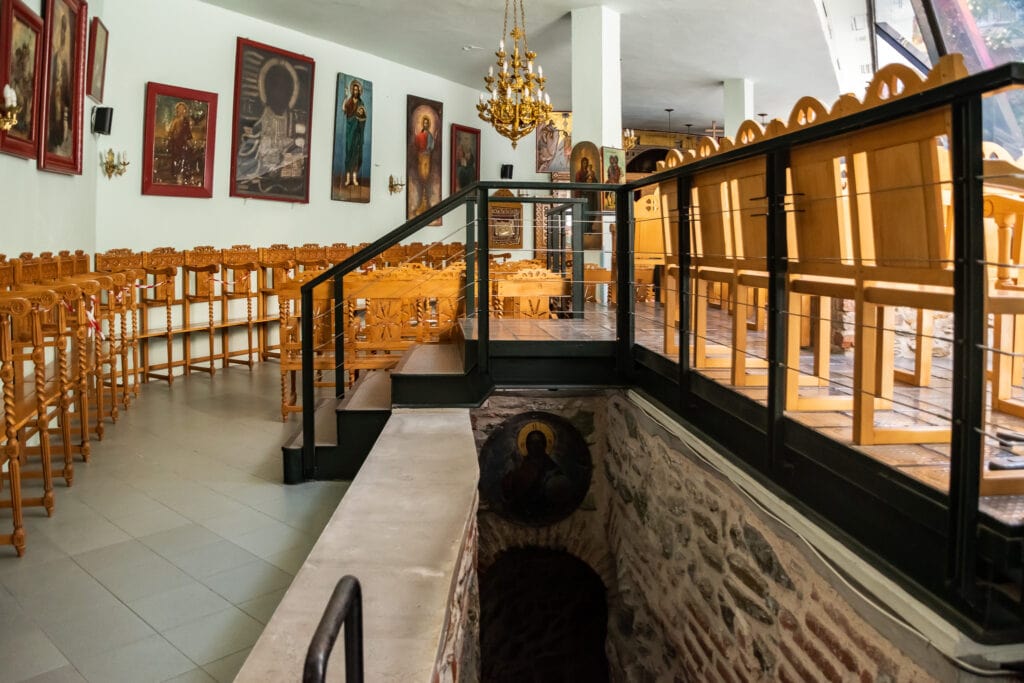
These catacombs and tunnels were used by the earliest Christians as a place of worship and refuge to practice their beliefs without persecution.
The White Tower
My walk continued down P. Mela Street to the historic White Tower of Thessaloniki. This tower is one of the city’s iconic sights. It was built in the 15th century by the Ottomans and was part of an extensive sea wall fortification system that included a number of towers.
Today, the White Tower is a museum that takes you through the history of Thessaloniki from its founding in 315 BCE to the present. Each floor focuses on a theme and uses traditional presentations and modern technology to make the history lesson both interesting and entertaining. Note that there is no elevator, and all floors are accessed via a wide, circular, stone stairway. The stone doorways are also quite low so watch your head.
By this time, the day was slowly coming to an end and the harborfront was a great place to watch the sun set. Thessaloniki has a large number of sculptures scattered throughout the city and the one of Alexander the Great om the waterfront is one of the most famous.
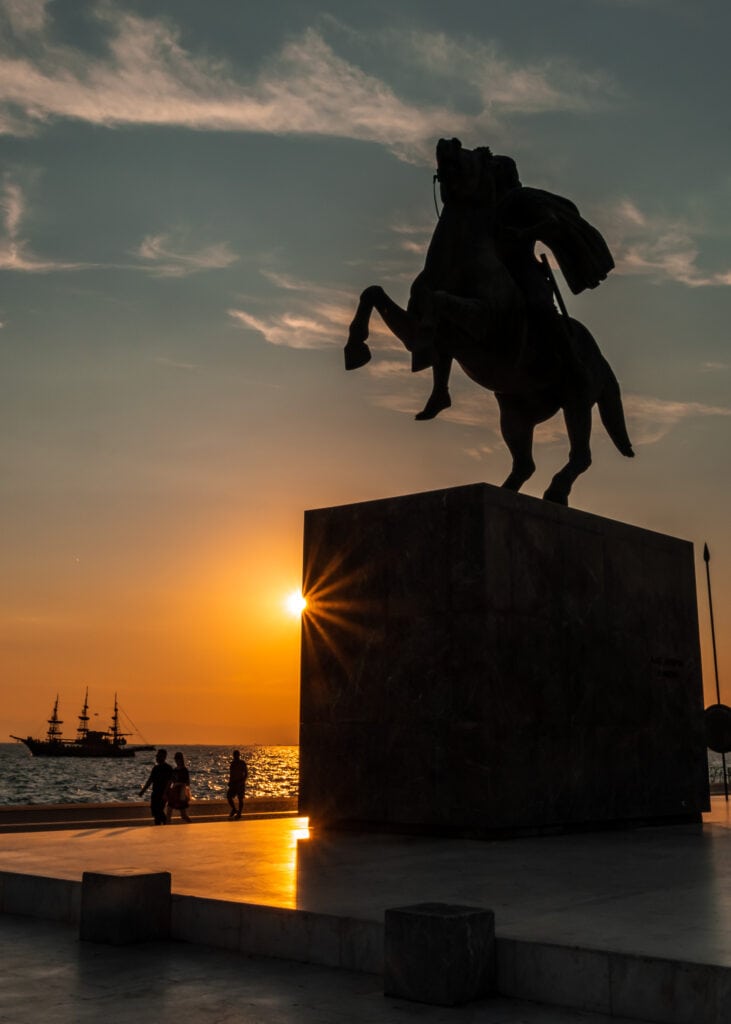
Another more modern sculpture nearby is the collection of metal umbrellas by Geroge Zongolopoulos. This was a lovely (and popular spot) for photos and sun set watching with both the locals and the tourists.

My day ended with a very nice dinner at the nearby Ovál Bistro with its fun blend of Asian and Mediterranean cuisine. It was a delicious meal of sushi with evening views of the lit up White Tower.
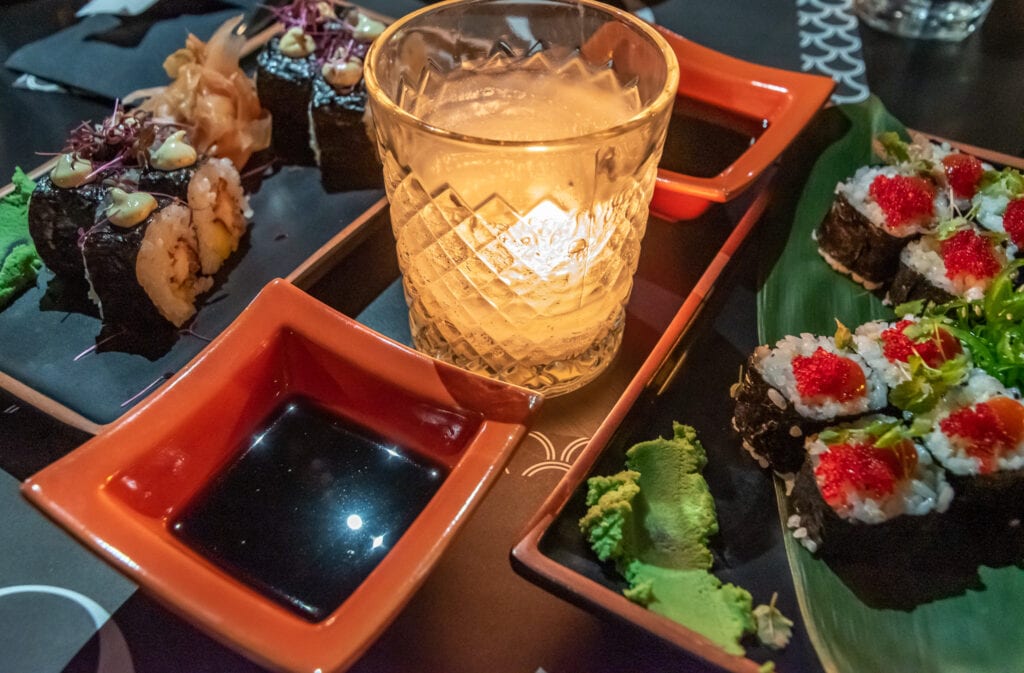
I want to thank my friend Sophia Bournatzi of the PASS PARTOUT marketing and tourism company for being my local travel guide and for giving me a chance to see Thessaloniki through her eyes.
Day 2 – Exploring Thessaloniki’s UNESCO World Heritage sites and more history
Scattered among the modern city buildings in Thessaloniki (and under them), you can easily find an open air history museum that spans 2300 years of continuous occupation. The city has some of the best preserved Byzantine art and architecture from the 4th century through the Ottoman conquest. In 1988, 15 of these Byzantine monuments were put on the UNESCO World Heritage list.
Since Thessaloniki has more UNESCO listed sites than any other Greek city, I knew I would not be able to visit all of them. Still, my goal for this second day in the city was to discover as many of the historic sites as time and energy allowed.
Travel tips – Note that the opening hours for some of these sites are short and can vary by season. You will want to look up when each is open and plan accordingly. The majority of the sites are free, but a few, like the Rotunda and the Castle, will have an entrance fee.
The castle and its walls
I took a cab to the high hill overlooking the city and the site of the Castle of Thessaloniki, because it is much easier to walk downhill than up. The castle is also called the Heptapyrgion or Yedi Kuli in Turkish which means seven towers (though there are actually 10). The castle and its walls were built over the original acropolis that was established by Cassender in antiquity.
It took about an hour to explore the large complex. The fortifications that are visible today span the range of time and history from the Roman, Byzantine, and Ottoman periods. More modern looking additions were put in place when the fortress was converted into a prison, which lasted for 100 years until 1989.
Vlatadon Monastery

A significant amount of the protective walls from the Middle Ages exists within Thessaloniki. I followed the wall for a few blocks down the hill through the narrow streets of Ano Poli, or the Old Town, to my next stop, the Vlatadon Monastery.
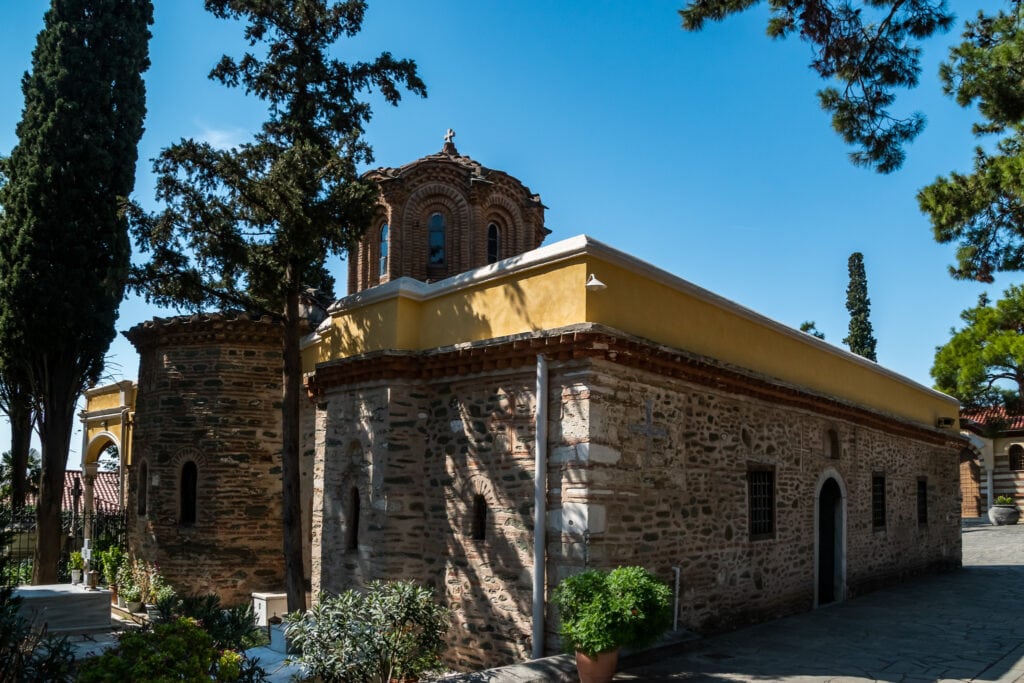
This restored monastery was started in 1351 and has been in continuous use since that time. Supposedly it was built on the site where Saint Paul preached during his visit to Thessaloniki.
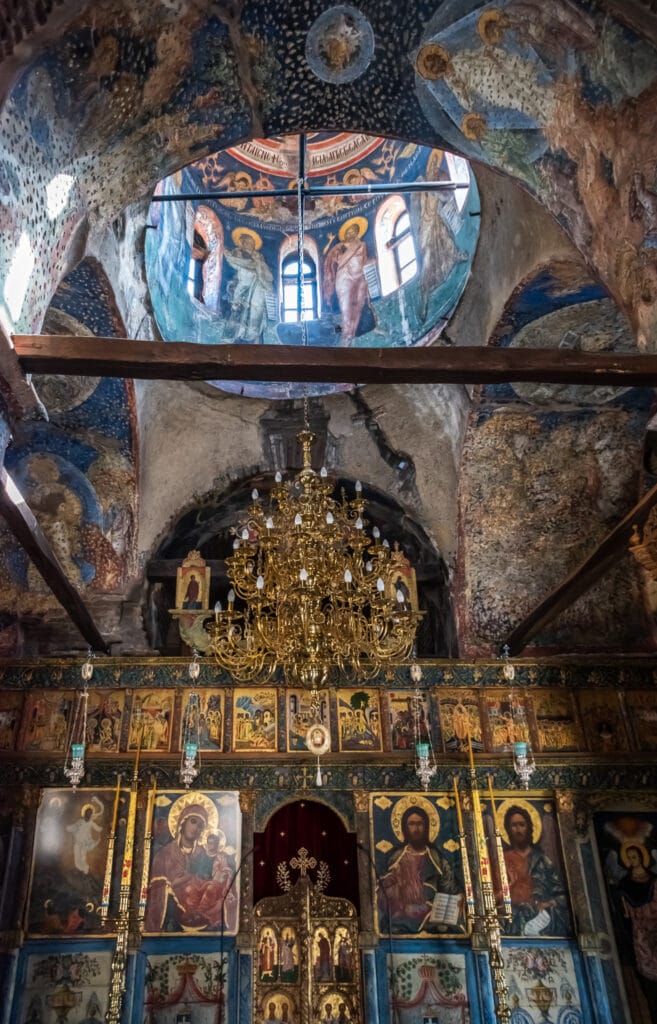
Inside there were beautiful frescoes from the 14th century. Despite the damage made during the Ottoman occupation (all the gouges on the walls were still visible), the beauty of these images was undeniable. The view from the monastery courtyard over the city to the bay below was also very pretty.

Latomos Monastery
Just down the hill from the Vlatadon Monastary I found the Church of Hosios David which was part of the Latomos Monastary. This small and intimate church from the late 5th century had some wonderful mosaics and frescoes inside which are thought to be from the 12th century.


Church of the Prophet Elijah
Continuing on downhill, I managed to get to the Church of the Prophet Elijah just before it closed for the day. This church was built in the 14th century and its architectural style is said to be unique in the city. Inside, only a small fragment of theearly interior paintings has remained.
Church of Saint Catherine
A little further on, I was only able to get an outside view of the 13th century Church of Saint Catherine since it had already closed to visitors for the day.

Ministry building
As I continued my walk, I passed the building for the Ministry of Macedonia, a relatively new architecture from the late 19th century. However, across the street where there were once soccer fields, ruins from the 4th century BCE were discovered – so now, no more soccer and the residents in the apartment buildings surrounding it get to look down on to (yet another) archeological site.
Byzantine Baths
Next was a quick pass by the Byzantine Baths. The baths were not open for touring, so I had to be satisfied with views of just the outside. These baths were from the late 12th century and were in operation until 1940.

Church of Saint Demetrius
A few more blocks downhill I stopped at Hagios Demetrios, the church dedicated to Saint Demitrius, the patron Saint of Thessaloniki. The church is best known for its beautiful mosaics that date from the 7th century CE. Despite the damage in the 1917 fire, the church has been beautifully restored.
Roman forum of Thessaloniki
Though not part of the UNESCO listed sites, the large Roman forum, also known as the ancient agora, is just a block away from St. Demetrius church. The forum complex was unearthed in the 1960’s when this area was dug up in preparation for building a new courthouse. The courthouse was relocated elsewhere, and the site was excavated to reveal a 2000 year old theater, baths, shops and other structures.
The Archeology Museum had a nice display about the Roman Forum with detailed descriptions of what each area was used for.
Church of Panageia Chalkeon
Across the street from the Roman forum, I found the 11th century Church of Panageia Chalkeon. The name of the church means “Virgin of the Copper Smiths” due to its location near the city’s copper smith neighborhood. Entrance into the church was already closed for the day so once again I had to be satisfied with just seeing the exterior.
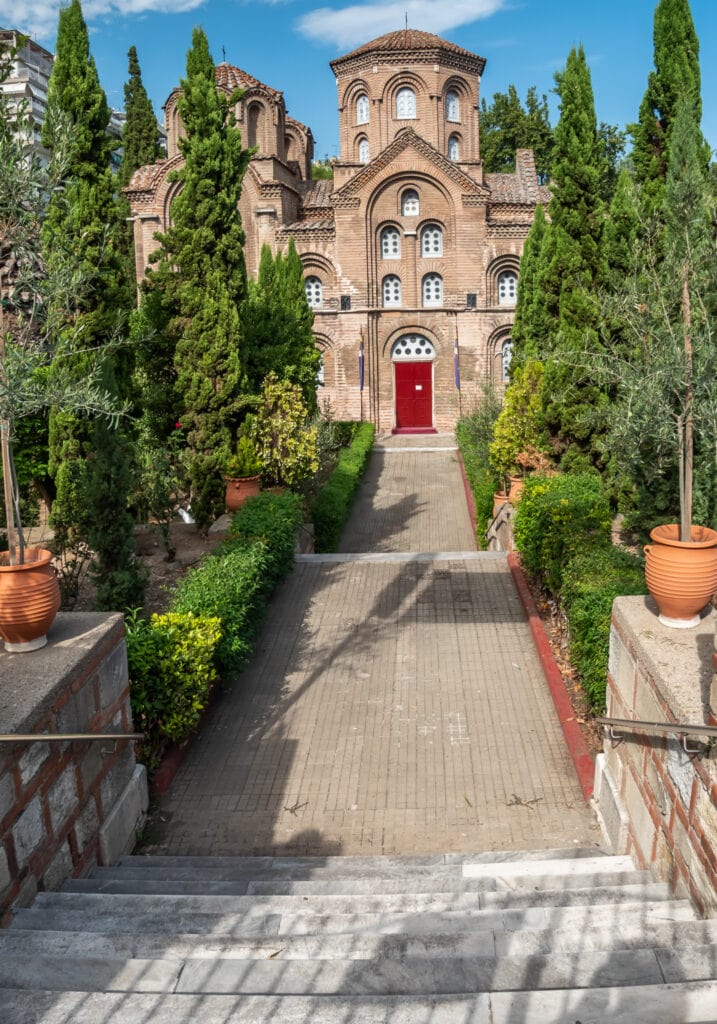
The Rotunda of Galerius
TAfter a late lunch in a small local restaurant, my next stop was the Rotunda. The Rotunda was built in 306 AD by the Roman ruler Galerius.
It is believed that the Rotunda was intended to be Ga;erius’ mausoleum. About 100 years later it was turned into a Christian church. Then, during Ottoman rule, as with many of the other churches in Thessaloniki, it became a mosque.
The architecture here is quite amazing. The Rotunda diameter is about 75 feet and it is about 90 feet high. To support this massive size, the walls are 18 feet thick. In the center of the dome there is an oculus, similar to the Pantheon in Rome.
Inside, some of the many beautiful mosaics that once covered the walls are still visible. Binoculars or a long telephoto lens really help to see the extensive intricate details of the scenes made with tiny pieces of colored glass.
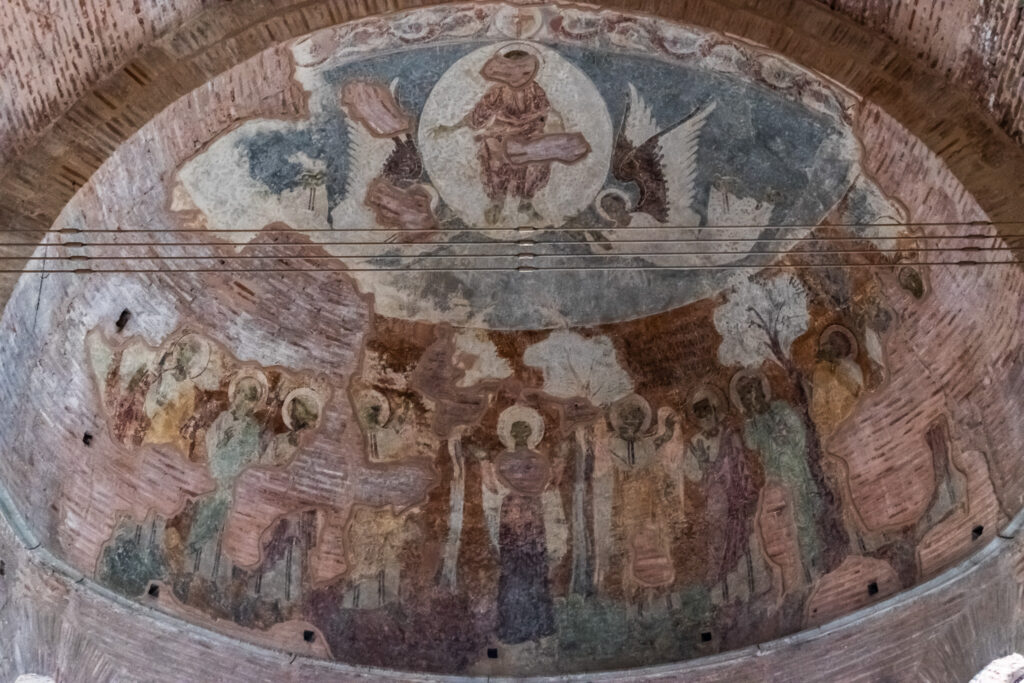
Some of the original Christian era paintings are also still visible.
Arch of Galerius
From the Rotunda, a processional road connected it to the Arch of Galerius, both of which were part of the greater Roman palace complex. The arch is also from the 4th century and was built to celebrate a successful battle against the Persians.

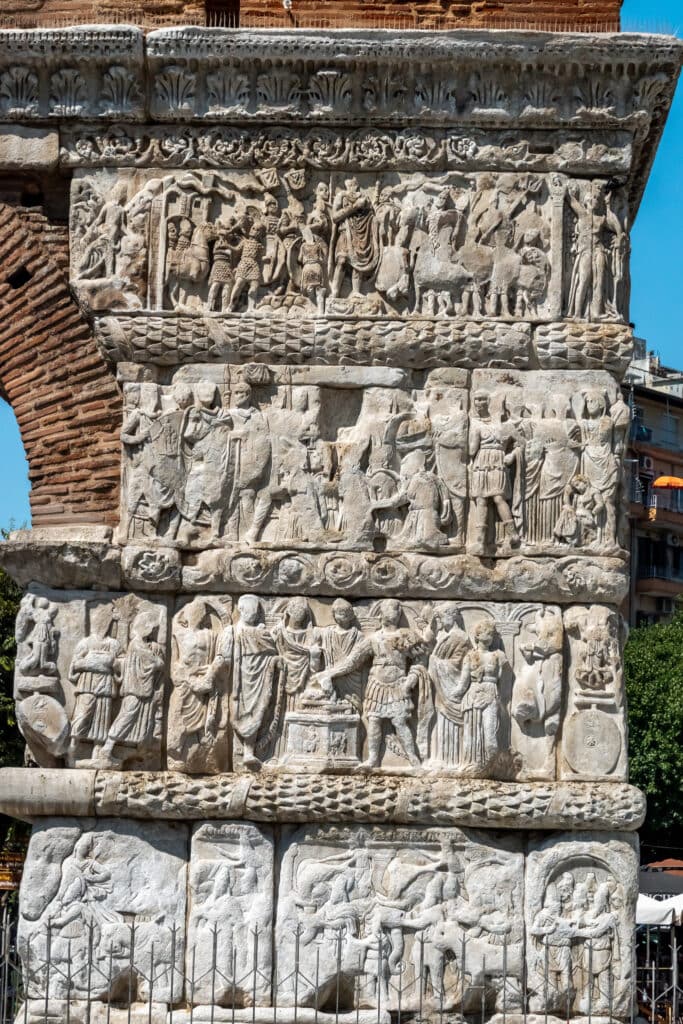
The Rotunda and the arch are part of what was once a very large Roman complex, much of which is buried under the modern buildings. At the end of the 3rd century, as Rome’s influence was waning and the Byzantine period was beginning, Caesar Gaius Galerius made Thessaloniki the seat of the eastern portion of the Roman Empire.
I continued a few more blocks toward the harbor on Dimitrou Gounari Street to find the dug up remains of the Palace of Galerius. Scattered among the modern apartment buildings, cafes and shops, sections of the palace have been exposed and preserve and include what was once a basilica, baths, a large house, along with other structures. I found the largest visible section of the palace at Navarinou Square.


My day of exploration took me to 10 of the 15 UNESCO sites in Thessaloniki, along with some of the city’s other ancient sites. I think I got a very good feel for the unique Byzantine architecture that was being preserved here.
Starting at the top of the hill above the city and working my way down worked out well as most of the sights were in somewhat of a line. It was also a lot less strenuous, especially during the heat of the day.
For your reference, this is the list of all the UNESCO listed monuments in Thessaloniki:
- City Walls (4th/5th centuries)
- Rotunda of Saint George (4th century)
- Church of Acheiropoietos (5th century)
- Church of St. Demetrios (7th century)
- Latomou Monastery (6th century)
- Church of St. Sophia (8th century)
- Church of Panagia Chalkeon (11th century)
- Church of St. Panteleimon (14th century)
- Church of the Holy Apostles (14th century)
- Church of St. Nicholas Orphanos (14th century)
- Church of St. Catherine (13th century)
- Church of Christ Saviour (14th century)
- Blatades Monastery (14th century)
- Church of Prophet Elijah (14th century)
- Byzantine Bath (14th century)
Day 3 – more history or beach time – so many choices
Before heading on to my next destination in Greece, I spent my 3rd day in Thessaloniki touring a few of the many museums in the city, learning more about ancient Greece history.
Archeology Museum
I spent a few hours exploring the Archeology Museum in Thessaloniki. I found its display to be a helpful supplement to everything I had seen in the previous two days. I especially liked the “Gold of Macedon” exhibit which had some beautiful pieces from the 6th to 2nd century BCE that were found in graves in the region.

The museum has information and artifacts from the Macedonia region starting with the bronze age in 3300 BCE and extending through antiquity. I really appreciated that all the displays provided information in both Greek and English.
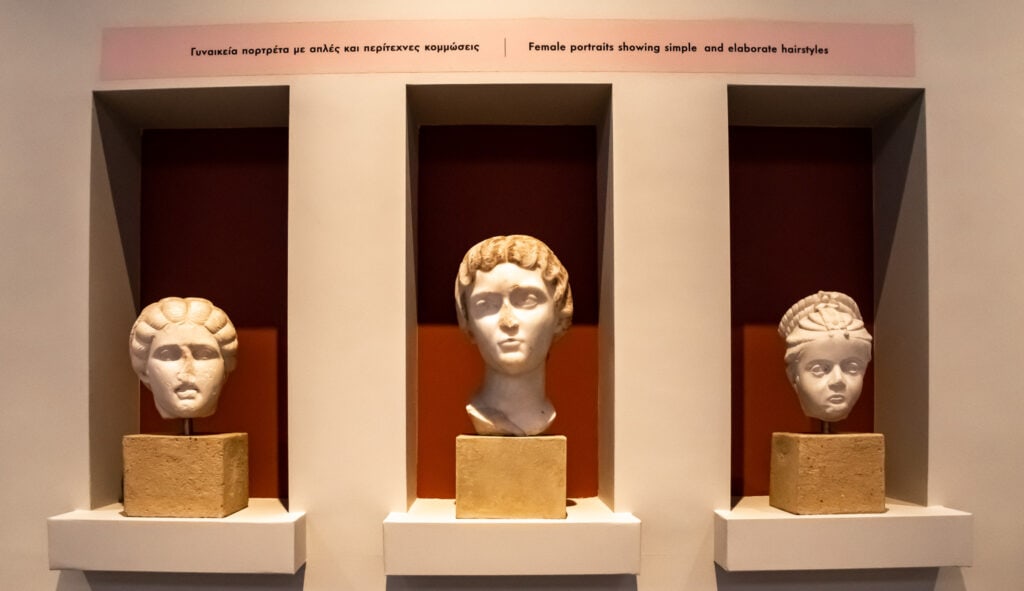
Museum of Byzantine Culture
Conveniently located across the street from the Archeology Museum was the Museum of Byzantine Culture. The 11 rooms describe how the Byzantine culture developed and also described the elements of 1000 years of Byzantine history in the region.
I especially liked the mosaic floors and painted walls of a house that were on display.
Besides these two, there are also a lot of other museums to choose from. Or you can take in one of the many cultural events. Or just spend the day relaxing at a few of the city’s cafes and people watch. Or visit more of the UNESCO sites you did not get to on the previous day. Use the official Thessaloniki travel website to discover all the local travel information you need for your visit.
You could also easily do a day trip to some of the other wonderful things to see in the region. The peninsula of Sithonia with its many beautiful beaches is only a little over an hour away. My post Discovering the Best Beaches in Sithonia, Greece can help you decide where to go.
If you want to see more UNESCO sites, The Archeological Site of Philippi is about a 2 hour drive from Thessaloniki, as are the monasteries of Mt. Athos. My posts Beyond the Ruins at the Archeological Site of Philippi and How to Visit Mt. Athos, Greece – Even if You Are a Female will give you helpful travel advice.
Where to stay in Thessaloniki
There are a lot of hotel options in Thessaloniki for every budget. For me, location is always a priority.
Normally I like to stay near the sights that I will be seeing, but this time, since I was driving into a big city, I didn’t want to deal with the busy traffic in the city center.
The Grand Hotel Palace offered a luxurious stay in an easy to get to location at the entrance into Thessaloniki. I parked my rental car in their free parking lot across the street for three days, and chose to let a taxi driver deal with the traffic congestion into and out of the city center.
My stay at the Grand Hotel Palace was a perfect mix of classic architecture on the outside and beautiful, modern and comfortable design on the inside. For a hotel in Europe, my premium room was extremely spacious and came with a king sized bed.
I especially loved the updated bathroom with the tiled walk in shower which I much prefer over a shower/bathtub combination.
I ate breakfast and dinner at the Grand Hotel Palace and can recommend both. I am not a big breakfast eater but can attest that the buffet here was extensive with something for every taste. I was quite happy with their fresh fruit choices and a crispy croissantearly in the morning.
One evening I enjoyed dinner al fresco in The Garden area in front of the hotel. As my main course I chose panzerotti with mushrooms, and braised veal cheeks topped with a spicy, hard, cheese from the island of Naxos, and it was delicious.

If you don’t want to eat outside, the indoor Seros restaurant offered the same menu. The Marco Polo bar in the lobby also had snacks and lighter fare, including fruit smoothies.
The Grand Hotel Palace is also Thessaloniki’s largest conference hotel and offers a variety of meeting spaces for large and small venues. There is also a health club with an indoor heated pool, a gym, a sauna, and a host of massages geared to your specific needs.
Strolling the streets of Thessaloniki during my visit, I saw buildings with beautiful neoclassical details along with 15th century Ottoman bath complexes and excavated Roman ruins and Byzantine churches. I saw lots of young people hanging out at cafes and families playing in the parks. There were priests and nuns in their traditional black Greek Orthodox garb and kids wearing logo t-shirts.
As I discovered, it is the way in which 2300 years of history, architecture, religion, and modern culture coexist so harmoniously together that gives Thessaloniki its unique character.
I hope this 3 day Thessaloniki itinerary gives you the inspiration you need to visit this lovely city.
Please note that my visit to Thessaloniki was part of the promo campaign “Urban Centers of Central Macedonia, Greece” and my stay was hosted by the Grand Hotel Palace. All content and opinions are my own and are a reflection of my personal experiences.
Other stories about Greece you may also like:
Discover the historic sites on the island of Kos – A Histroy Lover’s Guide to One Day in Kos, Greece
Thanks for visiting.
Rose
Pin this!





